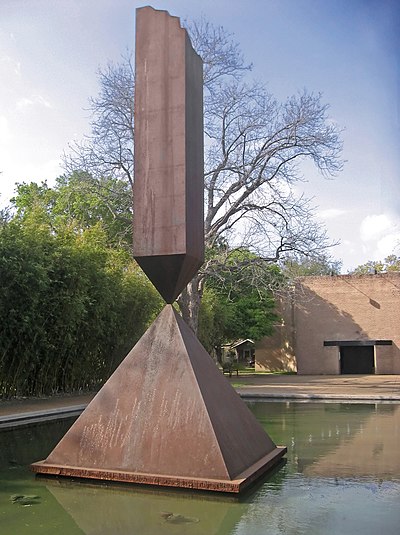John and Dominique de Menil founded the nondenominational Rothko Chapel in Houston, Texas.
The interior doubles as a chapel and a significant piece of modern art thanks to the fourteen paintings by Mark Rothko in various shades of black that are displayed on its walls.
The architect had a significant impact on both the chapel’s design and the building’s shape, an octagon inscribed in a Greek cross.
The chapel is located on the grounds of the University of Saint Thomas two miles to the southwest of downtown, in the Montrose district, between the structure housing the Menil Collection and the Chapel of Saint Basil. Annual attendance at the chapel is around 110,000 people.
Susan J. Barnes states “The Rothko Chapel…became the world’s first broadly ecumenical center, a holy place open to all religions and belonging to none. It became a center for international cultural, religious, and philosophical exchanges, for colloquia and performances. And it became a place of private prayer for individuals of all faiths”
The Rothko Chapel was added to the National Register of Historic Places on September 16, 2000.
The Rothko Chapel shows the relationship between art and architecture as artist, Mark Rothko works with various architects to bring the Chapel to reality.
Works of Art
In addition to the building itself, the chapel is linked to numerous pieces of art in the fields of music, painting, and sculpture.
Paintings
The chapel has fourteen of Rothko’s works on exhibit. Triptychs are displayed on three walls, while single paintings are shown on the remaining five walls. A series of black paintings with various dark colors and texture characteristics that Rothko started creating in 1964. Visitors often ask some variation of “Where are the paintings?” after taking in the enormous black canvases that cover the chapel’s walls.

In 1964, the de Menils presented Rothko with a commission for the chapel. He created the fourteen large paintings and four alternates between the fall of 1964 and the spring of 1967. These works shared many traits with the earlier black paintings from 1964.
Sculpture
Broken Obelisk, a striking sculpture by Barnett Newman, was placed in front of the chapel in 1970. The artwork, which honors the memory of Martin Luther King Jr., who was murdered in 1968, is located in a reflecting pool created by Philip Johnson.
The sculpture originally stood in Washington, D.C. and was offered in 1969 by the de Menils as a memorial to King to stand in front of Houston City Hall.

When Houston declined the offer, the de Menils gave the sculpture and the Rothko paintings to the Rothko Chapel as a start-up donation.
Music
The chapel, which is also known as Rothko Chapel (1971) served as the inspiration for one of Morton Feldman’s most well-known compositions, which was composed to be played in the chapel.
A trip to the chapel served as the inspiration for the 1992 song “Fourteen Black Paintings” by singer Peter Gabriel. The song “Rothko Chapel,” written by David Dondero, may be found on his album Simple Love from 2007. Harmonic chanting was performed by visiting Tibetan Gyuto Tantric monks in April 1986.
Houston Grand Opera’s HGOco commissioned and premiered an opera in 2017 about the chapel called Some Light Emerges, with music by Laura Kaminsky, concept by Mark Campbell and libretto by Campbell and Kimberly Reed.
Architecture
The chapel is an unruly octagonal brick structure with skylights and walls made of gray or rose stucco.
Eight simple, movable benches are provided for meditative seating, and additional ones are available to fit the audience for special events. It serves as both a meditation space and a meeting hall. There are holy books from several religions available.
The louvered skylight diffuser, which was updated in 2020 by Architectural Research Office and George Sexton Associates, is made up of 280 reflective metal blades that are individually oriented and positioned to ensure an even distribution of light onto the artworks along the perimeter walls.


